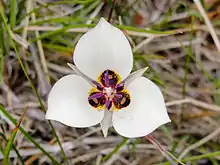Calochortus excavatus
Calochortus excavatus is a species of flowering plant in the lily family known by the common name Inyo County star-tulip.[3][4]
| Calochortus excavatus | |
|---|---|
 | |
| Scientific classification | |
| Kingdom: | Plantae |
| Clade: | Tracheophytes |
| Clade: | Angiosperms |
| Clade: | Monocots |
| Order: | Liliales |
| Family: | Liliaceae |
| Genus: | Calochortus |
| Species: | C. excavatus |
| Binomial name | |
| Calochortus excavatus | |
| Synonyms[2] | |
|
Calochortus campestris Davidson | |
Distribution
The flowering plant is endemic to eastern California, where it is known from several reduced and threatened populations in Mono and Inyo Counties.[5] It occupies grassy habitats in alkaline Shadscale scrub plant communities, alongside Atriplex and other playa halophyte flora, primarily in Owens Valley.[4]
The species is listed as endangered, threatened by the loss of local groundwater.[6]
Description
Calochortus excavatus is a perennial bulb, growing a slender unbranched stem to about 30 centimetres (12 in) in maximum height.[3]
The inflorescence bears 1 to 6 erect bell-shaped flowers in a close cluster. Each flower has three sepals which lack spotting, and three white petals. The petals may have green striping on their outer surfaces and generally have a red-purple blotch at the base. The anthers are reddish to purple.[3][7]
See also
- Endemic flora of California
- Natural history of Inyo County, California
- Shadscale scrub plant community
- Saltbush scrub plant community
References
- "NatureServe Explorer 2.0".
- Kew World Checklist of Selected Plant Families
- Flora of North America
- Calflora taxon report, Calochortus excavatus E. Greene, Inyo County star tulip
- Biota of North America Program 2014 county distribution map
- California Native Plant Society Inventory of Rare and Endangered Plants of California, Calochortus excavatus
- Jepson Manual Treatment for Calochortus excavatus
External links
- USDA Plants Profile of Calochortus excavatus (Inyo County star-tulip)
- Calochortus excavatus — Calphotos Photo gallery, University of California
- California Native Plant Society, Bristlecone Chaper, Calochortus excavatus, “Inyo County Star-tulip” photo and range iniformation
